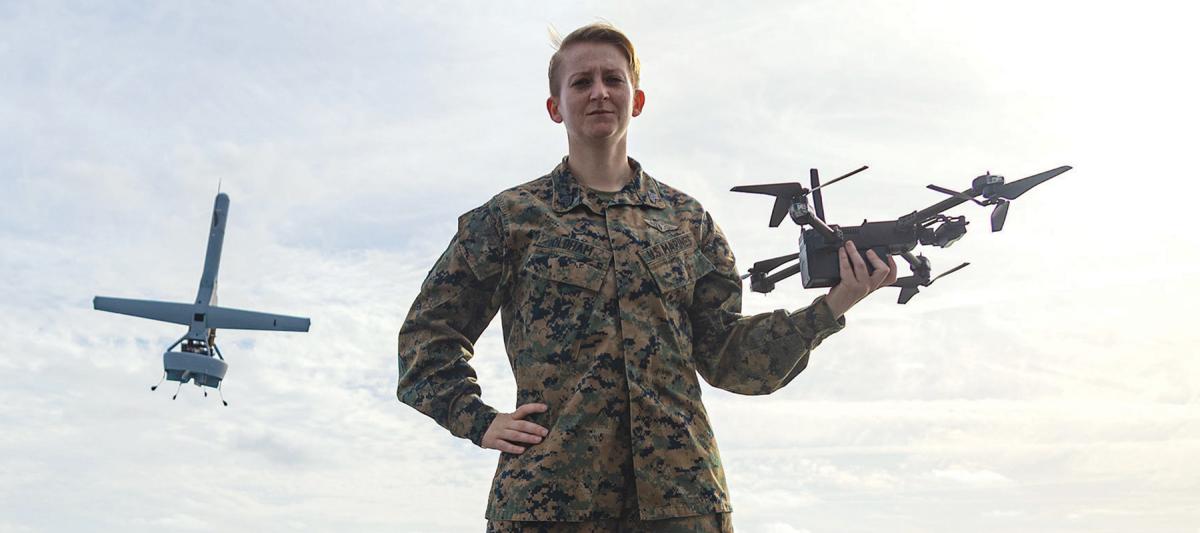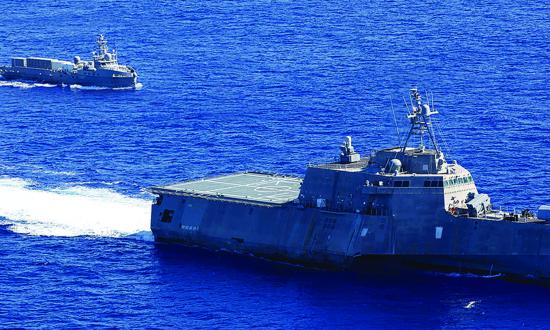If the Navy wants to pursue the “urgent change at significant scale” called for in the 2018 National Defense Strategy by employing hundreds or thousands of unmanned systems, it needs to field and integrate them on existing warships. Detachments of Marines deployed on board Navy vessels would be best positioned to employ small and medium-sized unmanned systems.
Marine detachments equipped with various such systems could provide intelligence, surveillance, reconnaissance (ISR), communication nodes, and precision strike. They could augment the organic capabilities of naval vessels while on board or push ashore when the mission requires. Unmanned aerial system (UAS)-equipped detachments could give even small naval or civilian vessels organic aviation capability and over-the-horizon ISR. Marines also could operate unmanned surface or underwater vessels (USVs or UUVs) from amphibious ships and littoral combat ships that could provide additional ISR and strike capabilities. These detachments also would allow sailors and Marines to cross-pollinate, building more effective Sea Services.
Meeting Demand
The Navy has dedicated significant assets to cover the vast Indo-Pacific region, but in 2017, then–Pacific commander Admiral Harry Harris said he had just 10 percent of the ISR assets he needed. “I don’t have the ability to persistently watch my adversaries all over the Indo-Asia-Pacific—over half the globe—24/7,” he testified, “and I need it 24/7.”1 It is a deficiency that could cost the Navy dearly in a future conflict.
In an attempt to fill its ISR gap, the Navy is acquiring 68 MQ-4C Tritons to operate in tandem with P-8A aircraft, but a Hudson Institute report assessed the Triton as “likely to become a high-demand, low-density asset.”2 The Navy’s MQ-8 Fire Scout program has foundered; 28 of the 38 MQ-8Cs initially procured are slated for storage, and all 30 of the original MQ-8Bs have been retired.3 In addition, there are not enough manned maritime domain awareness platforms. The Navy’s P-8A procurement plans lag warfighting requirements by 21 aircraft.4
The Navy needs inexpensive, expendable ISR platforms for stand-in forces to complement the high-end capabilities of theater assets. Small Marine detachments equipped with small and medium-sized UASs can provide this capability.
The ongoing Russia-Ukraine war is the most recent demonstration that unmanned systems are capable and affordable and can be decisive when employed at scale. The war has seen prolific drone use, with the introduction of new tactics and expanded capabilities. Both sides have turned to drones to supplement their depleted stocks of munitions and perform high-risk ISR. Cheap drones and loitering munitions are being used to target personnel, artillery pieces, tanks, airfields, and ships.5
Many of these lessons apply to naval combat and the maritime domain. Some authors have argued that loitering munitions could be employed effectively against warships, because even a relatively small warhead could score a mission kill if it struck critical systems such as radars and communications. And USVs have proven adept at sinking Russian naval vessels in the Black Sea. In the cluttered and complex littoral environment, ISR will be even more important, and medium-endurance UASs will be effective because engagements will be at closer ranges.
Past as Prologue
U.S. Marines have a long and storied history of serving on board naval vessels. Early in their history, they were trained to fight other ships from the deck and in the rigging. Through World War II, Marine detachments manned auxiliary batteries, ran the ship’s brig, guarded the vessel in port, and led parties of sailors ashore.
After the war, Congress reaffirmed the role of Marine detachments in the 1947 National Security Act, which directed the Marine Corps to provide “detachments and organizations for service on armed vessels of the Navy.”6 But over time, Marines’ role was reduced to securing nuclear weapons on board aircraft carriers, and the last detachment on board a carrier stood down in 1993. The last detachment on any vessel stood down in 1998.
Deploying detachments of Marines equipped with unmanned systems would be another chapter in Marines’ history of serving on board ships to augment the capabilities of naval vessels and further service integration.
Expeditionary Shipboard Unmanned Systems
Force Design 2030 notes:
As a “stand-in” force of the future, the Marine Corps requires a family of UAS capabilities. We need to transition from our current UAS platforms to capabilities that can operate from ship, from shore, and able to employ both collection and lethal payloads.7
The Marine Corps has embraced this guidance and is moving to increase the number of battalions and squadrons that field unmanned systems and acquire the Shield AI MQ-35 V-BAT to enable further operating concepts.8 The V-Bat takes off and lands vertically, eliminating the need for catapults or skyhooks. Consequently, it has a much smaller operational footprint than the ScanEagle or RQ-21 and even could operate from small naval vessels that lack flight decks, such as patrol craft and optionally manned or unmanned surface vehicles. At the larger end, the Marine Corps recently declared initial operating capability for its second MQ-9A Reaper squadron in Hawaii, with more squadrons planned.9
Marine Corps detachments equipped with later-generation UASs will expand the sensor range and connectivity of Navy vessels or convoyed civilian vessels that lack organic ISR platforms in two tactically significant ways. First, using UASs for targeting instead of a ship’s mounted radars could offer geometric advantages and allow ships to limit their electromagnetic signature while maintaining situational awareness. Second, Marine detachments could temporarily deploy ashore as part of an expeditionary advanced base (EAB). In this scenario, the UAS would launch from the ship under emission control and fly autonomously to a control point in a contested or hostile environment. Marines at the EAB then could take direct control of the UAS or leave the drone in an autonomous mode and instead receive one-way data bursts.10 Marine detachments also could add value to the fleet in counter-UAS against smaller threats.11
Group 3 and smaller tactical UASs have the versatility and ability to operate in austere environments and possess robust sensor payloads.12 New technology and future generations of unmanned systems, including underwater unmanned vehicles, will only increase the capability of Marine detachments. The Indo-Pacific theater’s expansive distances and high threat environment demand nothing less.
Culture Matters
Tactical considerations support Marine UAS teams on board naval vessels, but their presence also would increase integration of the Navy–Marine Corps team. The Marine Officer’s Guide already recommends junior Marine officers serve afloat: “The intimate experience that you gain as to Navy ways, operating procedures, capabilities and limitations will prove invaluable to you throughout the rest of your career.”13 The argument for embarking Marines on naval vessels could stand on cultural merits alone.
A More Lethal Fleet
Deploying detachments of Marines with existing and future small and medium-sized unmanned systems on board ships could augment the lethality and ISR coverage for the fleet as a whole. Marines who integrate with naval vessels also would better understand fleet tactics, maneuvering, and targeting, enhancing unit-level understanding of commander’s intent. Likewise, the Navy officers and enlisted personnel working with these Marines to achieve sea control would gain practical warfighting knowledge.
While every Marine is a rifleman, the high-end fight demands that every rifleman be ready to support the Navy fleet from the air, land, and sea.
1. Mark Selinger, “PACOM Can Meet Only 10 Percent of Its ISR Needs, Commander Says,” Defense News, 27 April 2017.
2. Seth Cropsey and Bryan McGrath, “If You Can’t See ’em, You Can’t Shoot ’em,” Hudson Institute, November 2019.
3. Richard Burgess, “Navy Is Sustaining 10 Operational MQ-8C Fire Scout UAVs; Rest in Storage,” Seapower, 31 January 2023.
4. Shaun McDougall, “U.S. House Appropriators Support a Larger P-8A Fleet,” Defense and Security Monitor, 23 May 2019.
5. Joshua Cheetham, “Sea Drones: What Are They and How Much Do They Cost?” BBC News, 13 September 2023.
6. Herb Richardson and R. R. Keene, “The Corps’ Salty Seadogs Have All But Come Ashore,” Naval History and Heritage Command, 5 September 2017.
7. Gen David H. Berger, USMC, Force Design 2030 (Washington, DC: Headquarters U.S. Marine Corps, March 2020).
8. Mike Ball, “V-BAT VTOL UAV to Support U.S. Marines,” Unmanned Systems Technology, 17 September 2020.
9. Hannah Venables, “VMU-3 Reaches MQ-9A Initial Operational Capability,” MarForPac, 4 August 2023.
10. Mark Pomerleau, “The Army Is Testing If It Wants to Operate Combat Drones Remotely,” C4ISRNet, 14 December 2017.
11. LCDR Frederick Cichon, USN (Ret.), “21st Century Marine Detachments for 21st Century Drone Warfare,” U.S. Naval Institute Proceedings 149, no 10 (October 2023).
12. Boeing, “RQ-21A BLACKJACK.”
13. Kenneth W. Estes, The Marine Officer’s Guide, 7th ed. (Annapolis, MD: Naval Institute Press, 2008).








